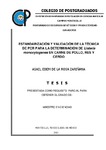Estandarización y validación de la técnica de PCR para la determinación de Listeria monocytogenes en carne de pollo, res y cerdo.
Abstract
Este trabajo de investigación tuvo como objetivo estandarizar y validar la técnica de PCR para la detección de Listeria monocytogenes en carne de pollo, res y cerdo, y evaluar la calidad microbiológica de la carne distribuida en puntos de venta de la ciudad de Texcoco de Mora, Estado de México. Se recolectaron 60 muestras de 250 g de carne de pollo (20), res (20) y cerdo (20), provenientes de establecimientos comerciales (tianguis, carnicerías y supermercados), realizando los muestreos en tres periodos a intervalos de 15 días (del 15 de octubre al 16 de noviembre), haciendo un total de 177 muestras de carne analizadas. Se evaluó la especificidad y la sensibilidad de los iniciadores MAR1-MAR2 y PRSF-PRSR para amplificar los genes iap y prs, respectivamente, mediante PCR para la detección de Listeria monocytogenes (Lm), bajo los resultados que arrojaron en el índice de McNemar y Kappa. Asimismo, se validó la PCR para la detección de Lm con relación al método microbiológico establecido en la NOM-143-SSA1-1995, basándose en el nivel de concordancia de ambas metodologías y el Teorema de Bayes. Por otro lado, se calculó la incidencia de Listeria monocytogenes en relación al tipo de carne y establecimientos. La concentración mínima de ADN detectable fue de 3 ng µL-1. La especificidad y sensibilidad de los iniciadores MAR1-MAR2 y PRSF-PRSR fue del 100%. El grado de acuerdo entre la PCR y el método microbiológico fue de 89, 92 y 90% para la carne de pollo, res y cerdo, respectivamente. La incidencia de Listeria monocytogenes fue de 68, 69 y 55% en carne de pollo, res y cerdo, de las cuales 84% de estas incidencias fueron en los tianguis y carnicerías y el 15.3% en supermercados. La técnica de PCR desarrollada resultó más sensible, específica y rápida para la detección de Listeria monocytogenes que el método microbiológico de la NOM-143-SSA1-1995. _______________ PCR ESTANDARIZATION AND VALIDATION FOR Listeria monocytogenes DETRMINATION ON CHICKEN, BEEF AND PORK MEAT. ABSTRACT: In order to standardize and validate the PCR technique for the Listeria monocytogenes detection on chicken, beef and pork meat, and evaluate the microbiological quality of meat distributed at sale points in Texcoco city this research was carried out. Sixty samples of chicken (20), beef (20) and pork (20) meat of 250 g each, were collected from commercial establishments (“tianguis”, butchers and supermarkets), sampling in three periods with 15 day of intervals (october 15th to november 16), add up to a total of 177 samples of meat analyzed. The Specificity and Sensitivity of primers MAR1-MAR2 and PRSF-PRSR were evaluated to amplify the iap and prs genes, respectively, by PCR for Listeria monocytogenes (Lm) detection and data were analyzed by the McNemar and Kappa index. PCR was also validated for the detection of Lm in relation to the microbiological method established in the NOM-143-SSA1-1995, according to the level of agreement of both methodologies and the Bayes Theorem. On the other hand, of Listeria monocytogenes incidence was calculated in relation to the meat type and establishments. The minimum detectable DNA concentration was 3 ng μL-1. The specificity and sensitivity of the primers MAR1-MAR2 and PRSF-PRSR was 100%. The degree of agreement between PCR and the microbiological method was 89, 92 and 90% for chicken, beef and pork meat, respectively. The incidence of Listeria monocytogenes was 68, 69 and 55% in chicken, beef and pork meat; 84% of these incidences were in tianguis and butchers and 15.3% in supermarkets. The PCR technique developed was more sensitive, specific and rapid for the detection of Listeria monocytogenes than the microbiological method of the NOM-143-SSA1-1995.
Collections
- Tesis MC, MT, MP y DC [403]


